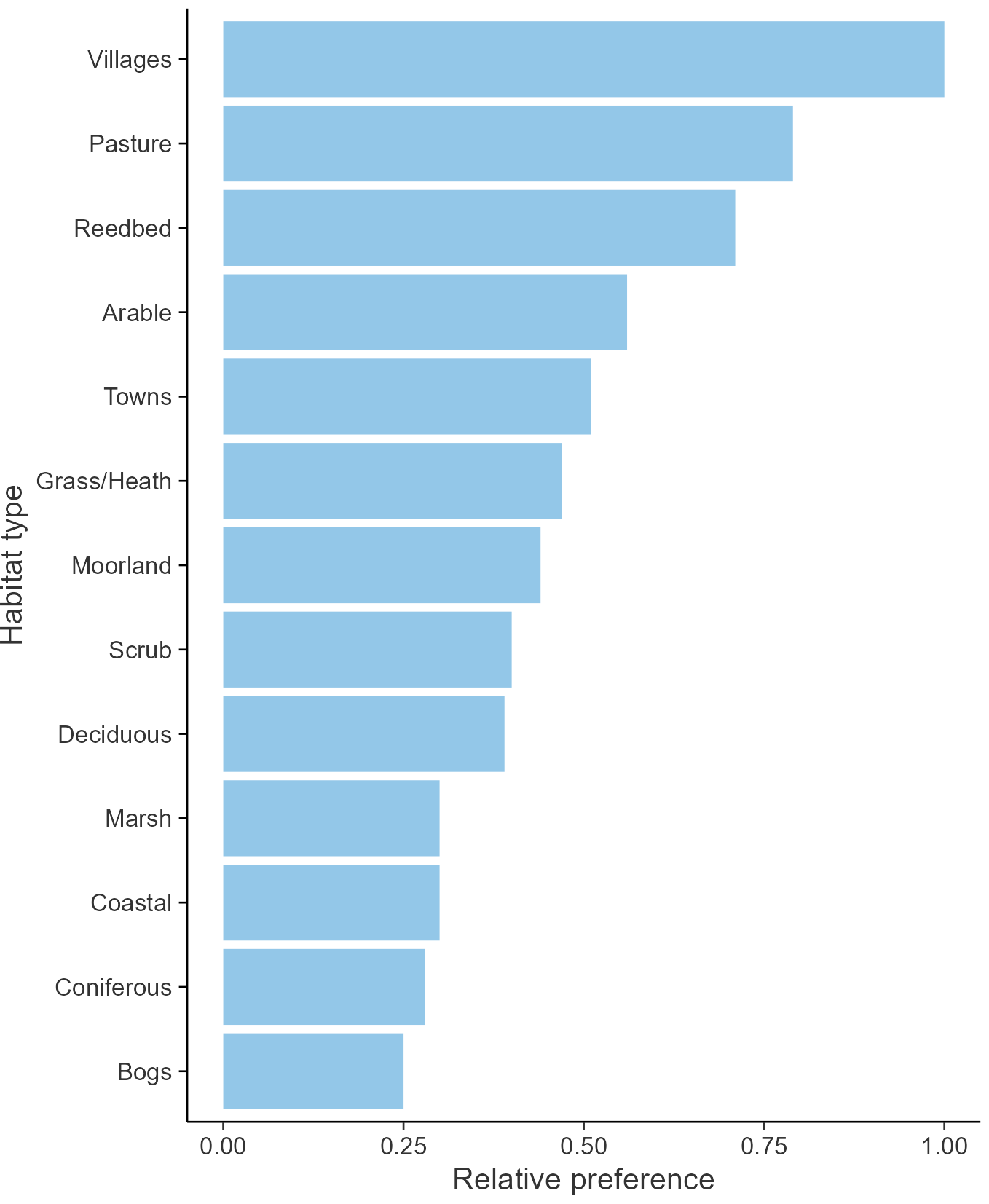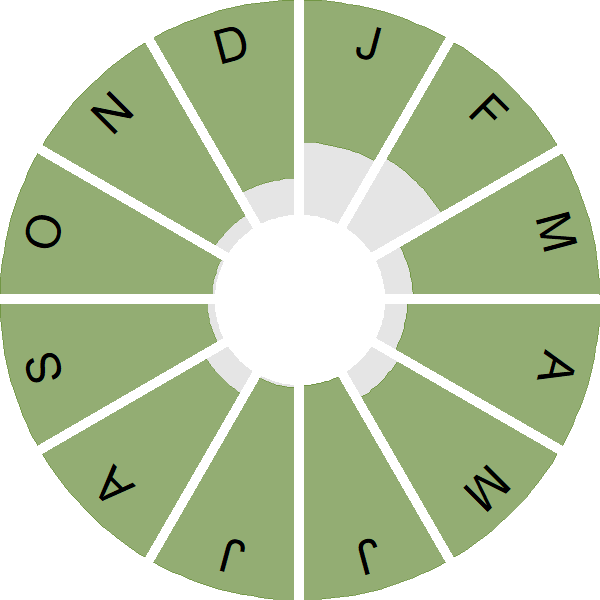Pied/White Wagtail

Introduction
The Pied Wagtail is a familiar bird and the most common wagtail species in Britain & Ireland. Its black, white and grey plumage and bobbing tail are distinctive.
The Pied Wagtail has a grey back and white face with black bib and crown. It is often seen running over the ground pursuing insect prey or 'wagging' its tail rapidly up and down. The species is confiding and frequents urban areas, gathering in large roosts on rooftops and in trees in winter. It has a characteristic "chirrup" call. It is widespread in Britain & Ireland, but is less common on higher ground in winter.
There are two subspecies of Moticilla alba. The subspecies Pied Wagtail (Moticilla alba yarrellii) is found throughout Britain & Ireland and is mostly sedentary, although ringing data show some winter movements into southern Europe. The subspecies White Wagtail (M. alba alba) is found in continental Europe, and is seen as a passage migrant.
- Our Trends Explorer gives you the latest insight into how this species' population is changing.

Key Stats
Identification
ID Videos
This section features BTO training videos headlining this species, or featuring it as a potential confusion species.
Yellow-coloured wagtails
Songs and Calls
Song:
Call:
Flight call:
Status and Trends
Conservation Status
Population Change
Britain and Ireland together hold almost the entire world population of the distinctive dark-backed race yarrellii (Pied Wagtail), and for this reason population changes in the UK are of global conservation significance. The CBC shows that a strong increase occurred up to the mid 1970s, such that populations have shown shallow increase overall since 1967. Since 1974, however, the results of monitoring have been somewhat conflicting: CBC/BBS and WBS/WBBS trends fluctuate in parallel but, whereas little overall change is evident in the CBC/BBS index, WBS/WBBS has shown a rapid decline, suggesting a strong influence of factors specific to linear waterways. The BBS map of change in relative density between 1994-96 and 2007-09 indicates that decrease occurred over that period throughout Scotland, away from the western coastal fringe, and in upland and urban areas of England and Wales, and increase mainly in Northern Ireland and westernmost Britain. The European long-term trend, which includes the nominate race of the species (White Wagtail), has been broadly stable since 1980 (PECBMS: PECBMS 2020a>).
Distribution
Breeding Pied Wagtails are almost ubiquitous in Britain & Ireland, being recorded in 95% of 10-km squares. Upland regions have low densities, although associated river valleys and foothills can support higher numbers. Densities are highest in lowland areas of the north and west but relatively low throughout England, even in grass-dominated areas. Pied Wagtails vacate upland areas of northern Scotland and northern England in winter, and densities are generally low in the northern half of Britain. Densities are high throughout Ireland.
Occupied 10-km squares in UK
or view it on Bird Atlas Mapstore.
or view it on Bird Atlas Mapstore.
European Distribution Map
Distribution Change
Breeding range has changed little and winter range has expanded slightly, mostly around the fringes of the uplands and often involving single birds or early returning breeders.
Change in occupied 10-km squares in the UK
or view it on Bird Atlas Mapstore.
or view it on Bird Atlas Mapstore.
Seasonality
Pied Wagtail is widely recorded throughout the year.
Weekly pattern of occurrence
The graph shows when the species is present in the UK, with taller bars indicating a higher likelihood of encountering the species in appropriate regions and habitats.

Habitats
Breeding season habitats
Relative frequency by habitat
The graph shows the habitats occupied in the breeding season, with the most utilised habitats shown at the top. Bars of similar size indicate the species is equally likely to be recorded in those habitats.

Movement
Britain & Ireland movement
Foreign locations of birds ringed or recovered in Britain & Ireland
Dots show the foreign destinations of birds ringed in Britain & Ireland, and the origins of birds ringed overseas that were subsequently recaptured, resighted or found dead in Britain & Ireland. Dot colours indicate the time of year that the species was present at the location.
- Winter (Nov-Feb)
- Spring (Mar-Apr)
- Summer (May-Jul)
- Autumn (Aug-Oct)

European movements
EuroBirdPortal uses birdwatcher's records, such as those logged in BirdTrack to map the flows of birds as they arrive and depart Europe. See maps for this species here.
The Eurasian-African Migration Atlas shows movements of individual birds ringed or recovered in Europe. See maps for this species here.
Biology
Productivity and Nesting
Nesting timing
Egg measurements
Clutch Size
Incubation
Fledging
Survival and Longevity
Survival is shown as the proportion of birds surviving from one year to the next and is derived from bird ringing data. It can also be used to estimate how long birds typically live.
View number ringed each year in the Online Ringing Report.
lifespan
Survival of adults
Survival of juveniles
Biometrics
Wing length and body weights are from live birds (source).
Wing length
Body weight
Ring Size
Classification, names and codes
Classification and Codes
- Order: Passeriformes
- Family: Motacillidae
- Scientific name: Motacilla alba
- Authority: Linnaeus, 1758
- BTO 2-letter code: PW
- BTO 5-letter code: PIEWA
- Euring code number: 10200
Alternate species names
- Catalan: cuereta blanca
- Czech: konipas bílý
- Danish: Hvid Vipstjert
- Dutch: Witte Kwikstaart
- Estonian: linavästrik
- Finnish: västäräkki
- French: Bergeronnette grise
- Gaelic: Breac-an-t-sìl
- German: Bachstelze
- Hungarian: barázdabillegeto
- Icelandic: Maríuerla
- Irish: Glasóg Shráide
- Italian: Ballerina bianca
- Latvian: balta cielava
- Lithuanian: baltoji kiele
- Norwegian: Linerle
- Polish: pliszka siwa
- Portuguese: alvéola-branca
- Slovak: trasochvost biely
- Slovenian: bela pastirica
- Spanish: Lavandera blanca
- Swedish: sädesärla
- Welsh: Siglen Fraith
- English folkname(s): Willy Wagtail, Dishwasher
Research
Causes of Change and Solutions
Causes of change
The causes of change for Pied Wagtail are unclear
Further information on causes of change
The long-term trend in abundance is similar to those shown by Wren and Long-tailed Tit, two other resident insectivores (Siriwardena et al. 1998a). Modelling suggests that climate change may have had a positive impact on the long-term trend for this species (Pearce-Higgins & Crick 2019). Average clutch and brood sizes have declined a little, but this has been counteracted by a large fall in nest failure rates. The number of fledglings per breeding attempt has shown a strong linear increase.
Information about conservation actions
There are currently no conservation concerns about the Pied Wagtail, and whilst numbers have fluctuated, the causes of change are unclear and hence no specific conservation actions have been proposed.

